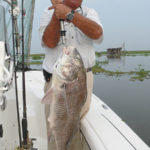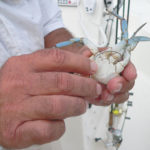
Trout, redfish abound at Bayou DuLarge
Doin’ the DU (pronounced “dew”) may sound like a 1960s dance fad, like doin’ the twist, or the watusi, or the hully gully.
But it’s actually what many of the locals have come to refer to fishing the Dularge area. Located about an hour-and-a-half from downtown New Orleans, Dularge represents a wide swath of marshes, bayous and bays almost due south from Houma, known for their abundance of speckled trout and redfish. The area stretches all the way to the Gulf of Mexico, and is prime habitat for anglers and hunters alike.
It was the lure of redfish that led me to call Capt. Gerald Ellender (985-688-1715) to see if I could hitch a ride on his boat to chase some of the big reds he’d reported catching.
Ellender grew up in the area, his family owning a houseboat out there for so long it’s a local landmark, and “Ellender’s Point” even shows up on many of the charts and maps of the area. I met one of Ellender’s long-time friends, Dan Rome, at the dock just past Jugs Marina, and we tossed our gear aboard Ellender’s 24-foot bay boat. We got under way just after sunup.
“October is a great month for fishing this area,” he said, “because the fronts will be coming through with some force and some consistency, and each time one comes down, it pushes the shrimp out of the marsh and into the passes.
“It’s an annual occurrence, and big numbers of speckled trout will move into the passes and the surrounding area to gorge on the shrimp. The action will just be incredible.”
Ellender says the trout will actually stage at the passes, waiting for the annual migration to begin.
“And once it begins, birds will show up by the thousands, hovering and diving over schools of shrimp in huge flocks, and they’ll be scattered everywhere, showing you right where to fish,” he said.
Personally, I love fishing the birds, and Ellender’s depiction of October action got my heart rate up. I was ready for some serious bird action. But there was one slight problem. It wasn’t quite October yet, and the big migration hadn’t started. The shrimp were not yet flushed out of the marsh into the passes. The trout weren’t stacked in there yet, and the birds were a no-show. (But by the time you read this, it’ll be on!)
So, we would focus on catching redfish this trip, and redfish is another commodity the DU has been producing in abundance.
“The passes from the marsh are holding some real nice-sized redfish and drum right now, and we’ll look for a spot in one of the deeper turns where we see some good current, and that’s where we’ll fish,” Ellender said.
After a relatively short ride, he pointed to a spot where the current was strong in a curve, and we tied off the boat to some structure.
“The water is about 20 feet deep here in this pass, and the current is strong, so we’re going to put a heavy sinker on and fish a Carolina rig on the bottom with cracked crab for bait,” he said. “The key is two-fold: You absolutely have to use enough weight to get your bait to the bottom, and that means ¾-ounce to 1½-ounce sinkers.
“If you don’t get all the way to the bottom, you are wasting your time. The bottom in these areas is littered with oysters, so you’ll need to bring a lot of extra tackle because you will lose some. In fact, if you’re not snagging the bottom occasionally and losing tackle, you’re either fishing in the wrong place or your bait isn’t getting all the way to the bottom.
“The other key is to use fresh bait, and I strongly recommend crab. You can buy bait crabs at Jugs Marina, and that’s what you need to get on a good redfish bite out here. Cut off the big claws, peel off the shell and cut the crab in half with a good pair of scissors. Use a No. 4 to a No. 6 kahle hook on a 2-foot leader (30-pound-test) and push the hook down between the legs of the crab and then come out between the legs. That’s the best way to hook them and keep the bait on your line.”
I don’t usually fish with crab for bait, so this technique was something of a new experience, and I wondered how effective it would be compared to using shrimp. I didn’t have to wonder very long! In minutes, I had a huge hit that nearly jerked the rod right out of my hand.
The big fish pulled and ran, and the strength of the run made me glad I was spooled with braided line. I do still have a few cork rigs spooled with mono, but I use those mainly for trout fishing. I’ve learned to appreciate the toughness of 30-pound braid for fishing reds.
The fish on the end of my line turned out to be a big drum that, once landed and weighed, tipped the scale at 17 pounds. It was just the first of many we’d catch that day, and several went into the 20-plus-pound range.
There were a few reds in the mix also, but we were catching drum five-to-one, and then we started catching the big drum almost exclusively.
“It’s odd,” Ellender said, “because most of the time we catch more reds than drum in here, but today is the opposite.
“We’ll move over to another deep curve in the pass and see what we find.”
Next stop was another turn with deep water and good current flow, and we started again dragging our crab on an oyster-strewn bottom.
Ellender said there are several choice spots to fish crab and find redfish out of the DU this month.
“Raccourci Bayou, between Raccourci Bay and Lake Mechant, is prime,” he said. “Look for deep holes in the turns, and good current lines.
“If you see an area in the turns where the current makes a good swirl, cast there. Big reds and drum choose such areas to ambush bait that flows with the current. You can also troll and fish the shoreline of Raccourci Bay and around the islands with gold spoons or spinnerbaits, and do the same along the east or west shorelines of Lake Mechant. I like the No. 4 Colorado-blade spinners, and a Bayou Chub in orange crush or the Texas roach color, just worked along the bank, at points and drains and coves. On any given day, you can easily catch a limit of reds just trolling those shorelines.
“Goose Bay is also an excellent place to fish for reds this month. I especially like to fish along the grass on a falling tide tossing weedless gold ½-ounce spoons, and Eagle Lake is another prime hotspot. A lot of tournament anglers like to fish Eagle Lake because it seems to produce the squat, heavy reds that win tournaments.
“And there are dozens of other great places to load the boat with reds in the DU. Lost Lake and Lake Carencro are both good places to just fish along the banks. Look for clear water and fish grasslines, and Bayou DeCade and Bayou Carencro have some great deep holes in the curves where you can anchor along the bank and fish the steep drop-offs around current lines. Soak some crab on the bottom, and you’ll catch some big fish.”
Ellender says crab on a Carolina rig is the best bait for fishing the deep holes, but in shallow water along the banks and along grasslines, you’ll want to toss gold spoons or beetle-spins.
“A ½-ounce weedless spoon is my favorite, but on very cloudy or overcast days, I’ll also use a black chrome spoon,” he said. “And on exceptionally clear-water days, I’ll go to a ¼-ounce spoon.
“Smaller bait is always more productive when you fish clear water. And in rough and murky water, a heavier spoon, like a ¾-ounce, produces better because it gives more flash.
“Now if you’re coming to the DU for trout this month, you’ll want to key in on a few important places. First on my list is the Raccourci at the north end of Lake Mechant. Time your trip so that you’re fishing a falling tide, and simply look for the birds. They’ll show you right where the fish are.
“Best baits: sparkle beetles (singles or tandem rigged) in clear or chartreuse fished 2 feet under a popping cork, DOA shrimp in glow, or Bayou Chubs in LSU, Cajun pepper, orange crush, limetreuse or glow/chartreuse, on a ¼-ounce jig.
Three-inch swim baits, like those made by Storm or Tsunami, in the glow color are also good producers.
“Another prime area is at Deer Bayou in the northeast corner of Lake Mechant, or at Goose Bay in the northwest side. At the south end of Lake Mechant, you can fish Grand Pass, and south of there you can fish around the island of the old Wildlife and Fisheries Camp, and again, look for birds. The key in all these areas is a falling tide and birds working over bait.
“Always approach them from upcurrent and kill your motor 50 yards away. Troll in quietly or just drift into them, and when you catch your first fish, stick the power pole or Cajun anchor, and sit on the action. Remember, the fish will stay there even when the birds fly off.
“Sometimes you’ll only catch small trout under the birds, but other times the fish will be very nice-sized. If you catch keeper trout, stay at least five or 10 minutes there after the birds fly off, or at least until it’s evident that the fish have moved on. Then pull up quietly and go chase another flock of birds.
“On a falling tide you should see huge flocks of birds all over, and you’ll also see a lot of other boats doing the same thing you’re doing, so you want to be courteous. There’s plenty room and plenty fish for everybody.”
I asked Ellender about his insistence on fishing a falling tide this month.
“By November and December, you’ll be able to effectively fish an incoming tide out here also,” he said. “Naturally, fishing moving water is essential anytime of year, whether its rising or falling.
“Still water pushes an invisible pause button on the fish’s instinct to feed. But in October, you definitely want to fish the falling tide. Remember, this is when the shrimp are being flushed out of the marsh and swept into the lake, and the birds and the trout will be all over them. It’s really a great time to fish the DU.”
Meanwhile, after making another move or two, we finally settled back in at our first stop of the day. This time the drum were absent, but the redfish were in session.
“It’s amazing — same spot, same bait, same conditions, just a few hours later, and a whole different experience,” Ellender said.
We were catching redfish hand over fist, at times two and even three hookups at a time. The fish ranged in size from 4 pounds to 8 and 9 pounds and up, and we sat there and wailed on them until we had our legal limits and were worn out.
I gained a whole new respect for using crab as redfish bait, and I can’t wait for October to “do the DU” for some of that trout-under-the-birds action.
Capt. Gerald Ellender can be reached at 985-688-1715.





